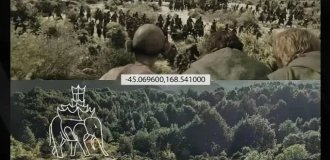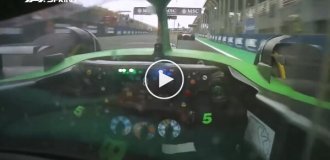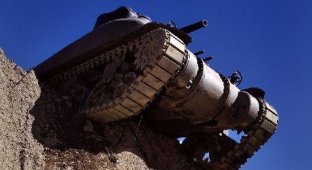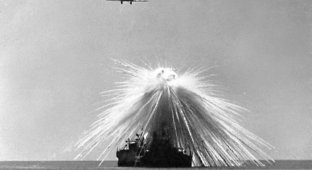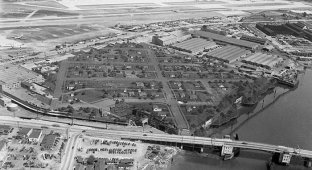Unique superweapon of the Third Reich (11 photos)
Next, we bring to your attention a list of unique weapons developed by Nazi Germany on the eve of and during the Second World War. Most of these superweapons were under development or were produced in such small quantities that they failed to influence the course of the war.

Horten Ho IX
Horten Ho IX is an experimental jet aircraft developed in Germany by the Horten brothers during the Second World War under a program popularly known as “1000-1000-1000” (an aircraft carrying a bomb load of 1000 kg over a distance of 1000 kilometers at a speed of 1000 km/h). It is the world's first jet-powered flying wing. Its first flight took place on March 1, 1944. A total of six copies were made, but only two flew into the air. Horten Ho IX is included in the ranking of the strangest aircraft of the Second World War.

Landkreuzer P. 1000 "Ratte"
Landkreuzer P. 1000 “Ratte” (“Rat”) is the designation of a super-heavy tank weighing about 1000 tons, which was developed in Germany in 1942–1943 under the leadership of design engineer Edward Grotte. In 1942, this project was approved by Adolf Hitler, but due to the lack of technology and equipment for production, the program was canceled in early 1943 on the initiative of Albert Speer. As a result, not even a prototype of the tank was built, the length of which, according to the drawings, would have been 39 meters, width - 14 meters, height - 11 m.

Dora
Dora is an 802 mm caliber railway gun, which was used during the storming of Sevastopol in 1942 and the suppression of the Warsaw Uprising in September-October 1944. Development of the project began in the late 1930s at the request of Adolf Hitler. In 1941, after testing, the Krupp company built the first gun, named “Dora”, in honor of the wife of the chief designer. In the same year, the second one was created - “Fat Gustav”. When assembled, "Dora" weighed about 1,350 tons; it could fire projectiles weighing 7 tons from a barrel 30 meters long at a distance of 47 kilometers. The size of the craters after the explosion of her projectile was 10 meters in diameter and the same in depth. The gun was also capable of penetrating 9 meters of reinforced concrete. In March 1945, Dora was blown up.

V-3
The V-3 ("Centipede", "Industrious Lischen") is a multi-chamber artillery gun developed at the end of World War II with the goal of destroying London and thereby avenging the Allied air raids on Germany. However, on July 6, 1944, when the gun was almost ready, three British bombers broke through German air defenses and damaged the V-3. The cannon complex was so damaged that it could no longer be restored. This gun was 124 m long and weighed 76 tons. It had a caliber of 150 mm and had a rate of fire of up to 300 rounds per hour. The mass of the projectile was 140 kg.

FX-1400
The FX-1400 is a German radio-controlled aerial bomb from World War II. It is the world's first precision weapon. The bomb was developed since 1938 in Germany and was used since 1942 to destroy heavily armored targets such as heavy cruisers and battleships. The main idea of the project was that the FX-1400 was dropped by a bomber from an altitude of 6000–4000 m at a distance of about 5 km from the target, which allowed the aircraft to be out of reach of enemy anti-aircraft fire. In total, about 1,400 bombs were fired, including trial models. Its length was 3.26 m, weight - 4570 kg.

V-2
The V-2 is the world's first ballistic missile, developed by German designer Wernher von Braun. It was adopted by Germany at the end of World War II. Its first launch took place in March 1942. The first combat launch was September 8, 1944. In total, about 4,000 copies were produced. There were 3,225 combat missile launches, mainly against targets in France, Great Britain and Belgium. The maximum flight speed of the V-2 rocket was up to 1.7 km/s, the flight range reached 320 km. The length of the rocket is 14.3 m.

Panzerkampfwagen VIII "Maus"
In fourth place on the list of unique superweapons of the Third Reich is the Panzer VIII “Maus” - a German super-heavy tank designed between 1942-1945 by Ferdinand Porsche. It is the heaviest tank (188.9 tons) ever built. A total of two copies were produced, none of which took part in battles. Only one Maus has survived in the world, assembled from parts of both copies, which is now stored in the Armored Museum in Kubinka, Moscow region.

Type XXI submarines
Type XXI submarines are a series of German diesel-electric submarines from World War II. Due to their late entry into service, they did not influence the course of the war, but until the mid-50s they had a significant influence on all post-war submarine shipbuilding. Between 1943 and 1945, 118 boats of this type were under construction in the shipyards of Hamburg, Bremen and Danzig. Only two took part in the fighting.

Messerschmitt Me.262
Messerschmitt Me.262 “Schwalbe” (“swallow”) is a multifunctional German jet aircraft from the Second World War. It is the first production jet fighter in history. Its design began in October 1938. It entered service in June 1944 and at that time was in many ways superior to traditional aircraft. For example, its speed was more than 800 km/h, which was 150–300 km/h faster than the fastest fighters and bombers. A total of 1,433 “swallows” were produced.

Solar cannon
The Sun gun is a theoretical orbital weapon. In 1929, German physicist Hermann Oberth developed a plan to create a space station consisting of 100-meter mirrors that would be used to reflect sunlight and focus it on enemy technology or any other object on Earth.
Later, during World War II, a group of German scientists at the artillery ranges in Hillersleben began creating superweapons that could harness solar energy. The so-called "solar cannon" would theoretically be part of a space station located 8,200 km above the Earth's surface. Scientists have calculated that a huge reflector made of sodium, covering an area of 9 square kilometers, could produce enough concentrated heat to burn down an entire city. When questioned in the United States, German scientists claimed that the solar cannon could be completed within the next 50 to 100 years.

